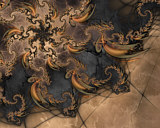|
Camera work has a profound effect on how a film is perceived and how succesful the director is in trying to get his or her ideas across. Various uses of the camera can affect a scene in such a way that, for example, a shot of a man walking across the landscape can be affected by how the scene is shot. Various types of camera placement and movement can determine the way a scene is perceived by the audience. One standard approach is the pan. Simply put, panning is the movement of the camera horizontally across a scene from a stationary axis point... in other words, the camera doesn't change position but only looks in a different direction. Slow pans are often used in longshots to show the expanse of a setting, for example a desert or tundra. Slow pans are used to move across a busy scene to finally focus on an individual person who is affected by the scene or to introduce a new character. Often pans are also used from the character's perspective in order to show what a character is looking at, especially a character looking for something. The pan can also be used to show the transition from one character to another... the reaction shot. The camera will actually play ping-pong, moving back and forth between characters as they speak, replicating what were to happen if the audience was a witness to a two-person conversation, for example. Another stationary position shot is the tilt, in which the camera moves up and down without changing position. This is often used to show, for example, the height of a building or the depth of the canyon, but also to essentially show a character's perspective, such as a potential suicide victim looking down over the edge of the building. The director of photography can also adjust focus to create effect. For example, using a soft indistinct focus on a female character can add to the notion of mystery, softness and sensuality, whereas a sharp focus can reveal, especially on a weather-worn face, the effects of time, stress or the elements. Furthermore, any given shot can focus on one individual character, making other characters indistinct and therefore emphasizing the importance of the in-focus character. Conversely, all of the elements within a shot can be in focus, making the shot busier and showing how the complexity of the setting affects the main character, or in order to show the reactions of other characters in the background to what is happening in the foreground with the dominant focus. The position of the camera in relation to its subject is partially discussed in relation to angle, which is the perspective from which the shot is taken. When the shot is taken from the floor and up at a subject, the subject seems more menacing or more regal. In Misery, Kathy Bates' character is usually shot from below to show her menacing nature even before she does anything to support that notion. Conversely, if the shot is taken at a high angle, the subject seems smaller and weaker... in the same movie, James Caan's character is often viewed from above to demonstrate his helplessness. To this end, there are several shots a director or director of photography can use to create these effects. For example, a crane shot, in which the camera is suspended from a crane, creates a bird's eye view of the scene, very often to show either a large scene, a great number of people, or to indicate that the character in the shot is at some risk or peril. Even higher than the crane shot is the aerial shot, which shows an even wider expanse and is, of course, often taken from a helicopter or airplane. This was effectively used in North by Northwest as the main character is being assaulted by an airplane and we see his vulnerability when he is viewed from above. In order to show movement, a dolly shot may be employed, which allows the camera to move along with a moving character. This type of action engages the watcher in such way that we are with the character on their journey... for example following Forrest Gump on his run across America. The camera is placed on a device with wheels in order to move along with the subject to create a smooth image. When a dolly shot is impractical or the director wants a less refined image, hand-held shot may be employed to create not only the perception of movement but also the idea that we are with the character running along... this type of shot draws attention to the camera work and in some ways seems less refined and more realistic. Often hand-held shots are used in crowd scenes not only to enable the crowd to further mill around the camera to create claustrophobic lack of space, but also to replicate what it would be like to be in the crowd, jostled along with the subject. When the director of photography is trying to close in on the subject, especially in a crowd scene when putting a camera within the scene is impractical, then he or she will often employ a Zoom shot, taken from a long angle lens which allows the viewer access to an individual in a crowd or perhaps on some inaccessible place, for example, a cliff or the side of a building. Overall, the use of the camera has a lot to do with how the cinematographer and the director choose to present a movie to the audience. How these creators present these images can make the movie successful or not, and more importantly, can get those ideas that the director and the writer had in mind to the audience. Giannetti, Louis. Understanding Movies. 11th ed. Pearson/Prentice hall, 2008. © T. T. Eiland, August, 2006 |
